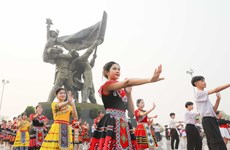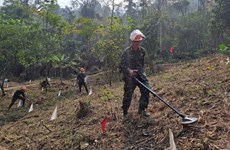Public school shortage in urban areas: pressing concerns
Many city dwellers in new urban areas are sending their children to
public schools in central Hanoi, despite crowded classes of up to 50
students.
Many city dwellers in new urban areas are sending their children to
public schools in central Hanoi, despite crowded classes of up to 50
students.
This is because they cannot afford the high fees charged by better-equipped private schools.
As a result, many modern private schools are virtually empty, while students in public schools are sometimes forced to study in residents' houses, hired by the schools due to a severe shortage of classrooms.
Nguyen Thu Le, a resident in Hoang Mai district's Linh Dam Urban Area, said she took her three-year-old son to a public pre-school in Hoan Kiem district over 10km away, despite there being an international pre-school right next to her house.
"The pre-school is quite good, with standard facilities and foreign teachers, but the monthly fees of more than 10 million VND (470 USD) are too much for me," Le said.
"I have no choice but to keep sending him to his old school, although I moved to this place nearly two years ago. The fees at the public school are one-third of those at the private school."
Le said her son's public school was overcrowded with 45 students per class, but accepted that "most public schools are in the same situation."
Le is not alone. Many parents in new urban areas have refused to send their children to standard private schools nearby due to expensive fees, even though there are no public schools nearby.
Figures from the municipal Department of Construction showed there were 38 schools across 10 new urban areas in the city. Only four of which were public schools - the rest were private or international models.
Thus, many schools in new urban areas – backed by investment of tens of billions of dong such as Global International School in Yen Hoa Urban Area and Thang Long Kidsmart in Dich Vong Urban Area in Cau Giay district – suffer a lack of students.
Nguyen Thi Hong Lien, CEO of Global International School told Tin Tuc (News) newspaper the school was built to international standards with a room for pre-schoolers spanning 100 square metres, a 60- square metre room for primary students, as well as other facilities. However, there were only 110 students across all grades.
"The fees are higher than public schools as our school's facilities are much better, but it hasn't attracted many students to enroll," she said.
In the meantime, students in public schools such as Le Ngoc Han Primary School and Ngo Thi Nham Primary School in Hai Ba Trung district have been seen queuing up outside temporary classrooms hired in nearby residents' houses.
Nguyen Nhu Thang, head of Hai Ba Trung district's Education and Training Sub-department said she had asked the city authority to provide more land to build schools for the last ten years, but it was difficult due to land fund shortages.
Vice head of the municipal Education and Training Department Pham Thi Hong Nga said the State always required investors in new urban areas to build schools before selling apartments to people, but many didn't follow these requirements.
To tackle the problem, the city has implemented regular inspections and requires investors to build schools in urban areas while they are still under construction.
For new urban areas where people have already moved in, the city has asked investors to quickly build nearby public schools to serve residents.-VNA
This is because they cannot afford the high fees charged by better-equipped private schools.
As a result, many modern private schools are virtually empty, while students in public schools are sometimes forced to study in residents' houses, hired by the schools due to a severe shortage of classrooms.
Nguyen Thu Le, a resident in Hoang Mai district's Linh Dam Urban Area, said she took her three-year-old son to a public pre-school in Hoan Kiem district over 10km away, despite there being an international pre-school right next to her house.
"The pre-school is quite good, with standard facilities and foreign teachers, but the monthly fees of more than 10 million VND (470 USD) are too much for me," Le said.
"I have no choice but to keep sending him to his old school, although I moved to this place nearly two years ago. The fees at the public school are one-third of those at the private school."
Le said her son's public school was overcrowded with 45 students per class, but accepted that "most public schools are in the same situation."
Le is not alone. Many parents in new urban areas have refused to send their children to standard private schools nearby due to expensive fees, even though there are no public schools nearby.
Figures from the municipal Department of Construction showed there were 38 schools across 10 new urban areas in the city. Only four of which were public schools - the rest were private or international models.
Thus, many schools in new urban areas – backed by investment of tens of billions of dong such as Global International School in Yen Hoa Urban Area and Thang Long Kidsmart in Dich Vong Urban Area in Cau Giay district – suffer a lack of students.
Nguyen Thi Hong Lien, CEO of Global International School told Tin Tuc (News) newspaper the school was built to international standards with a room for pre-schoolers spanning 100 square metres, a 60- square metre room for primary students, as well as other facilities. However, there were only 110 students across all grades.
"The fees are higher than public schools as our school's facilities are much better, but it hasn't attracted many students to enroll," she said.
In the meantime, students in public schools such as Le Ngoc Han Primary School and Ngo Thi Nham Primary School in Hai Ba Trung district have been seen queuing up outside temporary classrooms hired in nearby residents' houses.
Nguyen Nhu Thang, head of Hai Ba Trung district's Education and Training Sub-department said she had asked the city authority to provide more land to build schools for the last ten years, but it was difficult due to land fund shortages.
Vice head of the municipal Education and Training Department Pham Thi Hong Nga said the State always required investors in new urban areas to build schools before selling apartments to people, but many didn't follow these requirements.
To tackle the problem, the city has implemented regular inspections and requires investors to build schools in urban areas while they are still under construction.
For new urban areas where people have already moved in, the city has asked investors to quickly build nearby public schools to serve residents.-VNA












